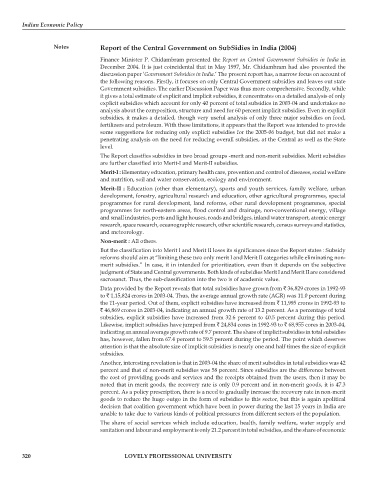Page 326 - DECO502_INDIAN_ECONOMIC_POLICY_ENGLISH
P. 326
Indian Economic Policy
Notes Report of the Central Government on SubSidies in India (2004)
Finance Minister P. Chidambram presented the Report on Central Government Subsidies in India in
December 2004. It is just coincidental that in May 1997, Mr. Chidambram had also presented the
discussion paper ‘Government Subsidies in India.’ The present report has, a narrow focus on account of
the following reasons. Firstly, it focuses on only Central Government subsidies and leaves out state
Government subsidies. The earlier Discussion Paper was thus more comprehensive. Secondly, while
it gives a total estimate of explicit and implicit subsidies, it concentrates on a detailed analysis of only
explicit subsidies which account for only 40 percent of total subsidies in 2003-04 and undertakes no
analysis about the composition, structure and need for 60 percent implicit subsidies. Even in explicit
subsidies, it makes a detailed, though very useful analysis of only three major subsidies on food,
fertilizers and petroleum. With these limitations, it appears that the Report was intended to provide
some suggestions for reducing only explicit subsidies for the 2005-06 budget, but did not make a
penetrating analysis on the need for reducing overall subsidies, at the Central as well as the State
level.
The Report classifies subsidies in two broad groups -merit and non-merit subsidies. Merit subsidies
are further classified into Merit-I and Merit-II subsidies.
Merit-I : Elementary education, primary health care, prevention and control of diseases, social welfare
and nutrition, soil and water conservation, ecology and environment.
Merit-II : Education (other than elementary), sports and youth services, family welfare, urban
development, forestry, agricultural research and education, other agricultural programmes, special
programmes for rural development, land reforms, other rural development programmes, special
programmes for north-eastern areas, flood control and drainage, non-conventional energy, village
and small industries, ports and light houses, roads and bridges, inland water transport, atomic energy
research, space research, oceanographic research, other scientific research, census surveys and statistics,
and meteorology.
Non-merit : All others.
But the classification into Merit I and Merit II loses its significances since the Report states : Subsidy
reforms should aim at “limiting these two only merit I and Merit II categories while eliminating non-
merit subsidies.” In case, it in intended for prioritization, even then it depends on the subjective
judgment of State and Central governments. Both kinds of subsidies Merit I and Merit II are considered
sacrosanct. Thus, the sub-classification into the two is of academic value.
Data provided by the Report reveals that total subsidies have grown from ` 36,829 crores in 1992-93
to ` 1,15,824 crores in 2003-04. Thus, the average annual growth rate (AGR) was 11.0 percent during
the 11-year period. Out of them, explicit subsidies have increased from ` 11,995 crores in 1992-93 to
` 46,869 crores in 2003-04, indicating an annual growth rate of 13.2 percent. As a percentage of total
subsidies, explicit subsidies have increased from 32.6 percent to 40.5 percent during this period.
Likewise, implicit subsidies have jumped from ` 24,834 cores in 1992-93 to ` 68,955 cores in 2003-04,
indicating an annual average growth rate of 9.7 percent. The share of implicit subsidies in total subsidies
has, however, fallen from 67.4 percent to 59.5 percent during the period. The point which deserves
attention is that the absolute size of implicit subsidies is nearly one and half times the size of explicit
subsidies.
Another, interesting revelation is that in 2003-04 the share of merit subsidies in total subsidies was 42
percent and that of non-merit subsidies was 58 percent. Since subsidies are the difference between
the cost of providing goods and services and the receipts obtained from the users, then it may be
noted that in merit goods, the recovery rate is only 0.9 percent and in non-merit goods, it is 47.3
percent. As a policy prescription, there is a need to gradually increase the recovery rate in non-merit
goods to reduce the huge outgo in the form of subsidies to this sector, but this is again apolitical
decision that coalition government which have been in power during the last 15 years in India are
unable to take due to various kinds of political pressures from different sectors of the population.
The share of social services which include education, health, family welfare, water supply and
sanitation and labour and employment is only 21.2 percent in total subsidies, and the share of economic
320 LOVELY PROFESSIONAL UNIVERSITY

